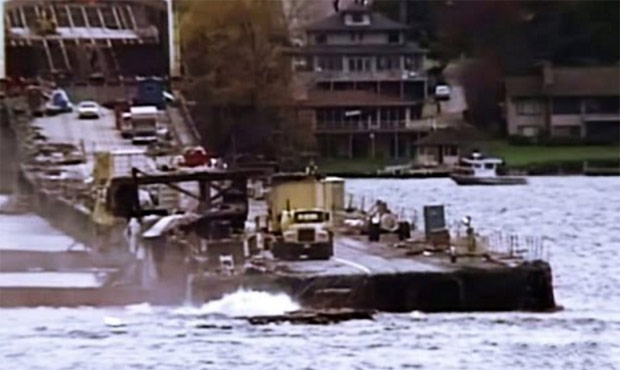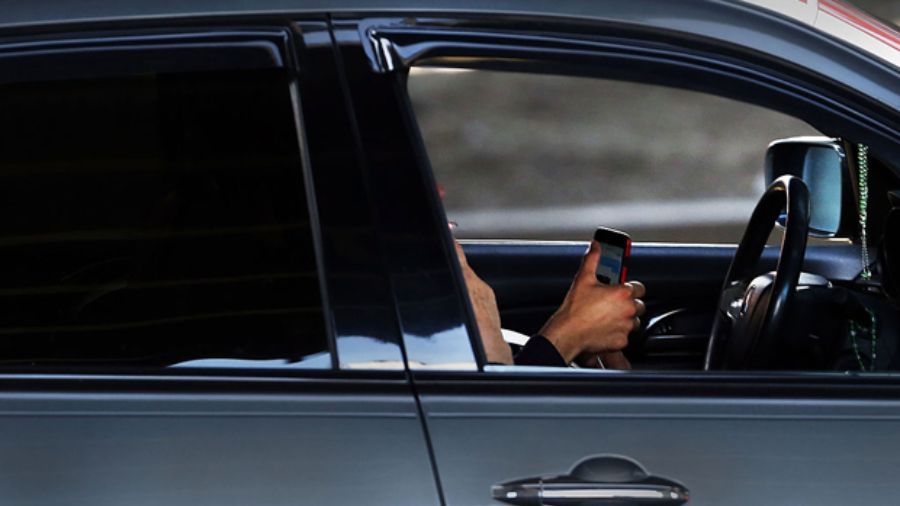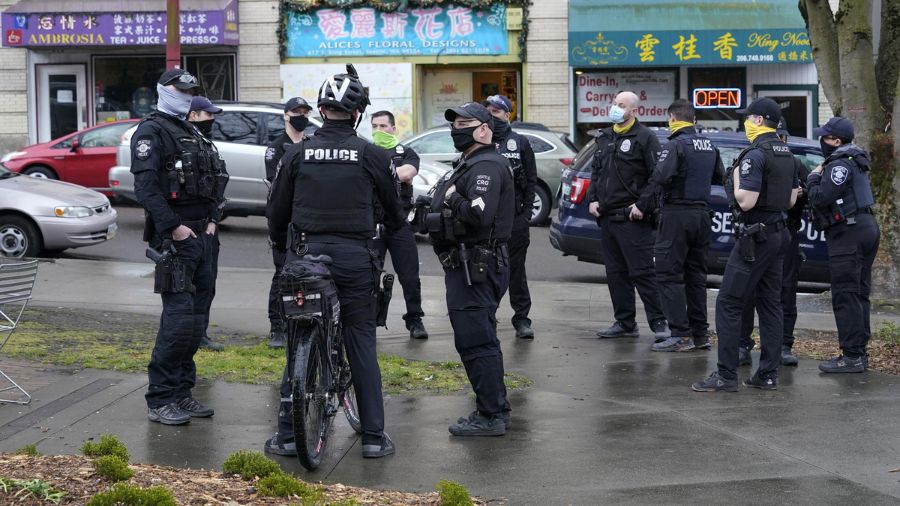Bizarre Lake Washington disaster struck Thanksgiving Weekend 1990
Nov 25, 2015, 5:31 AM | Updated: Jul 28, 2022, 11:53 am

The Lacey V. Murrow floating bridge sank to the bottom of Lake Washington on Nov. 25, 1990. (Video screengrab)
(Video screengrab)
It was 27 years ago that a bizarre disaster struck, sending major portions of the old Lacey V. Murrow floating bridge to the bottom of Lake Washington.
The bridge was an engineering marvel when it was built in 1940. It was made from concrete sections called “pontoons” that are shaped like barges. They float on the lake surface, and are anchored to the bottom with steel cables. The pontoons are connected together to form the long bridge from the Mount Baker neighborhood to Mercer Island. Non-floating “high rise” structures at each end also hold the pontoons in place and allow for boats to pass underneath.
Listen: KIRO traffic reporter flies over sinking bridge
By the morning of Nov. 25, 1990, the bridge was 50 years old. It had been closed to vehicle traffic for nearly two years and a new bridge had been built alongside. Crews from an Illinois-based company called Traylor Brothers were working on a $30 million project to renovate the old bridge. Plans were to update the 1940 pontoons with a new road surface and other improvements. The Washington State Department of Transportation was spending a total of $1.5 billion to improve seven miles of the I-90 corridor into downtown Seattle.
It had been stormy that week. River valleys were flooded. Washington Governor Booth Gardner took a helicopter tour of waterlogged areas and said, “My state is falling apart on me.”
Out on Lake Washington, high winds, rain and waves were striking the old pontoons. Before the storm hit and over the previous months, in order to strip away the old surface on the 1940 bridge, construction crews had been using a process called “hydrodemolition.” This involved directing high-pressure jets of water at the old concrete, as well as storing wastewater inside the pontoons and then pumping it at regular intervals into barges for disposal.
The late Paul Brendle was KIRO Radio’s traffic helicopter pilot back then. He’d been flying around that Sunday morning getting a look at flooding in the Snoqualmie Valley from the heavy rains that week. Right around 9 a.m., KIRO got an anonymous phone tip that something big was going on at the old bridge.
Kari Gondry — known then as Kari Owen — was working as the news editor that morning, and took the call from the tipster. She says she called Brendle up in his helicopter immediately on the two-way radio.
Gondry was fresh out of college and something of a rookie in the newsroom. “I told Paul, ‘Hey, stop what you’re doing and head over to the bridge.’ I think he thought I was crazy because I was just this kid. And I said, ‘No, no. You gotta do it. Head that direction,'” Gondry said.
Brendle pointed the copter toward the middle of Lake Washington. He arrived over the bridge just in time to deliver a gripping live play-by-play.
“Approximately a third of the old Mercer Island floating bridge that they have been rehabilitating has broken away from the west end and has drifted out at an angle approximately 20 degrees,” Brendle told KIRO anchors Linda Thomas and Rick Van Cise and thousands of listeners that Sunday morning.
“And here it goes now,” Brendle continued. “There’s a huge yellow crane, one of those big construction cranes. And when I made the last pass over a few moments ago, Rick, it was in fact high and dry. And now it’s up to the top of its wheels. So this crane will be pitching over any moment and going underwater. It will also go to the bottom of Lake Washington,” Brendle said. “And another section of the bridge is now giving away, breaking as I’m watching it. Right now the concrete is bubbling. Now it lifts up. The entire section is canted about a 40 degree angle, just like a big battleship rolling over and getting ready to pitch straight down. The crane is gone now,” he said.
The handful of workers on the bridge that morning evacuated safely and nobody was injured when the old bridge sank. But as those old concrete pontoons disappeared beneath the waves, they damaged the anchor cables on the adjacent new bridge, and created a serious potential safety threat.
With wind in the forecast, authorities decided to bring in tugboats to hold the new bridge in place until repairs could be made. Because of this, the new bridge was closed to vehicles for a few days. Traffic between Seattle and the Eastside was a mess, with the Evergreen Point floating bridge on State Route 520 the only available option for crossing Lake Washington.
A study of the disaster later determined that multiple factors were to blame for the dramatic sinking of the old bridge. Water had likely been accumulating in the old pontoons from the beginning of the “hydrodemolition” process, and there were other water intrusion problems created when access holes were cut into the concrete and not properly sealed.
Related: Harrowing Burien airliner crash covered up by time
Further exacerbating these problems were a lack of sufficient water-level monitoring devices inside the pontoons, and too few pumps on-site to save the bridge once the problem was noticed that Sunday morning. Planning and execution of the project, the report said, should have considered the marine aspects of the structure and the demolition work.
“The principles of good marine practice were not a specific contract requirement, nor were they followed on this project,” the report said. “While everyone must have understood that a floating bridge could sink, the thought that a sinking was a real risk must have been remote.”
WSDOT later sued the contractor for $69 million but ultimately settled for just $20 million. The replacement Lacey V. Murrow floating bridge opened to vehicle traffic in 1994 and continues to serve tens of thousands of commuters every day.
In 1991, KIRO Radio won a prestigious Edward R. Murrow Award for their coverage of the sinking of the Lacey V. Murrow floating bridge. The bridge’s namesake was director of the Washington State Highway Department in the 1930s and 1940s, and grew up in Skagit County.
Ironically, the namesake for the award KIRO won was Lacey’s famous CBS newsman brother, Ed. Thus, this was the first, and so far the only time a Murrow Award has involved two of the Murrow brothers.













